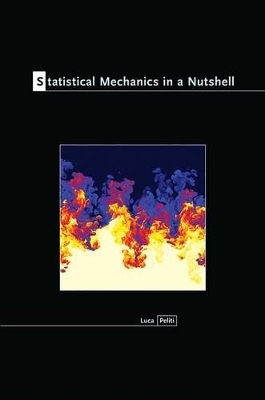
Statistical Mechanics in a Nutshell
Princeton University Press (Verlag)
978-0-691-14529-7 (ISBN)
Statistical mechanics is one of the most exciting areas of physics today, and it also has applications to subjects as diverse as economics, social behavior, algorithmic theory, and evolutionary biology. Statistical Mechanics in a Nutshell offers the most concise, self-contained introduction to this rapidly developing field. Requiring only a background in elementary calculus and elementary mechanics, this book starts with the basics, introduces the most important developments in classical statistical mechanics over the last thirty years, and guides readers to the very threshold of today's cutting-edge research. Statistical Mechanics in a Nutshell zeroes in on the most relevant and promising advances in the field, including the theory of phase transitions, generalized Brownian motion and stochastic dynamics, the methods underlying Monte Carlo simulations, complex systems--and much, much more. The essential resource on the subject, this book is the most up-to-date and accessible introduction available for graduate students and advanced undergraduates seeking a succinct primer on the core ideas of statistical mechanics.
* Provides the most concise, self-contained introduction to statistical mechanics * Focuses on the most promising advances, not complicated calculations * Requires only elementary calculus and elementary mechanics * Guides readers from the basics to the threshold of modern research * Highlights the broad scope of applications of statistical mechanics
Luca Peliti is professor of statistical mechanics at the University of Naples Federico II in Italy. His books include "Biologically Inspired Physics".
Preface to the English Edition xi Preface xiii Chapter 1: Introduction 1 1.1 The Subject Matter of Statistical Mechanics 1 1.2 Statistical Postulates 3 1.3 An Example: The Ideal Gas 3 1.4 Conclusions 7 Recommended Reading 8 Chapter 2: Thermodynamics 9 2.1 Thermodynamic Systems 9 2.2 Extensive Variables 11 2.3 The Central Problem of Thermodynamics 12 2.4 Entropy 13 2.5 Simple Problems 14 2.6 Heat and Work 18 2.7 The Fundamental Equation 23 2.8 Energy Scheme 24 2.9 Intensive Variables and Thermodynamic Potentials 26 2.10 Free Energy and Maxwell Relations 30 2.11 Gibbs Free Energy and Enthalpy 31 2.12 The Measure of Chemical Potential 33 2.13 The Koenig Born Diagram 35 2.14 Other Thermodynamic Potentials 36 2.15 The Euler and Gibbs-Duhem Equations 37 2.16 Magnetic Systems 39 2.17 Equations of State 40 2.18 Stability 41 2.19 Chemical Reactions 44 2.20 Phase Coexistence 45 2.21 The Clausius-Clapeyron Equation 47 2.22 The Coexistence Curve 48 2.23 Coexistence of Several Phases 49 2.24 The Critical Point 50 2.25 Planar Interfaces 51 Recommended Reading 54 Chapter 3: The Fundamental Postulate 55 3.1 Phase Space 55 3.2 Observables 57 3.3 The Fundamental Postulate: Entropy as Phase-Space Volume 58 3.4 Liouville's Theorem 59 3.5 Quantum States 63 3.6 Systems in Contact 66 3.7 Variational Principle 67 3.8 The Ideal Gas 68 3.9 The Probability Distribution 70 3.10 Maxwell Distribution 71 3.11 The Ising Paramagnet 71 3.12 The Canonical Ensemble 74 3.13 Generalized Ensembles 77 3.14 The p-T Ensemble 80 3.15 The Grand Canonical Ensemble 82 3.16 The Gibbs Formula for the Entropy 84 3.17 Variational Derivation of the Ensembles 86 3.18 Fluctuations of Uncorrelated Particles 87 Recommended Reading 88 Chapter 4: Interaction-Free Systems 89 4.1 Harmonic Oscillators 89 4.2 Photons and Phonons 93 4.3 Boson and Fermion Gases 102 4.4 Einstein Condensation 112 4.5 Adsorption 114 4.6 Internal Degrees of Freedom 116 4.7 Chemical Equilibria in Gases 123 Recommended Reading 124 Chapter 5: Phase Transitions 125 5.1 Liquid-Gas Coexistence and Critical Point 125 5.2 Van der Waals Equation 127 5.3. Other Singularities 129 5.4 Binary Mixtures 130 5.5 Lattice Gas 131 5.6 Symmetry 133 5.7 Symmetry Breaking 134 5.8 The Order Parameter 135 5.9 Peierls Argument 137 5.10 The One-Dimensional Ising Model 140 5.11 Duality 142 5.12 Mean-Field Theory 144 5.13 Variational Principle 147 5.14 Correlation Functions 150 5.15 The Landau Theory 153 5.16 Critical Exponents 156 5.17 The Einstein Theory of Fluctuations 157 5.18 Ginzburg Criterion 160 5.19 Universality and Scaling 161 5.20 Partition Function of the Two-Dimensional Ising Model 165 Recommended Reading 170 Chapter 6: Renormalization Group 173 6.1 Block Transformation 173 6.2 Decimation in the One-Dimensional Ising Model 176 6.3 Two-Dimensional Ising Model 179 6.4 Relevant and Irrelevant Operators 183 6.5 Finite Lattice Method 187 6.6 Renormalization in Fourier Space 189 6.7 Quadratic Anisotropy and Crossover 202 6.8 Critical Crossover 203 6.9 Cubic Anisotrophy 208 6.10 Limit n 209 6.11 Lower and Upper Critical Dimensions 213 Recommended Reading 214 Chapter 7: Classical Fluids 215 7.1 Partition Function for a Classical Fluid 215 7.2 Reduced Densities 219 7.3 Virial Expansion 227 7.4 Perturbation Theory 244 7.5 Liquid Solutions 246 Recommended Reading 249 Chapter 8: Numerical Simulation 251 8.1 Introduction 251 8.2 Molecular Dynamics 253 8.3 Random Sequences 259 8.4 Monte Carlo Method 261 8.5 Umbrella Sampling 272 8.6 Discussion 274 Recommended Reading 275 Chapter 9: Dynamics 277 9.1 Brownian Motion 277 9.2 Fractal Properties of Brownian Trajectories 282 9.3 Smoluchowski Equation 285 9.4 Diffusion Processes and the Fokker-Planck Equation 288 9.5 Correlation Functions 289 9.6 Kubo Formula and Sum Rules 292 9.7 Generalized Brownian Motion 293 9.8 Time Reversal 296 9.9 Response Functions 296 9.10 Fluctuation-Dissipation Theorem 299 9.11 Onsager Reciprocity Relations 301 9.12 Affinities and Fluxes 303 9.13 Variational Principle 306 9.14 An Application 308 Recommended Reading 310 Chapter 10: Complex Systems 311 10.1 Linear Polymers in Solution 312 10.2 Percolation 321 10.3 Disordered Systems 338 Recommended Reading 356 Appendices 357 Appendix A Legendre Transformation 359 A.1 Legendre Transform 359 A.2 Properties of the Legendre Transform 360 A.3 Lagrange Multipliers 361 Appendix B Saddle Point Method 364 B.1 Euler Integrals and the Saddle Point Method 364 B.2 The Euler Gamma Function 366 B.3 Properties of N-Dimensional Space 367 B.4 Integral Representation of the Delta Function 368 Appendix C A Probability Refresher 369 C.1 Events and Probability 369 C.2 Random Variables 369 C.3 Averages and Moments 370 C.4 Conditional Probability: Independence 371 C.5 Generating Function 372 C.6 Central Limit Theorem 372 C.7 Correlations 373 Appendix D Markov Chains 375 D.1 Introduction 375 D.2 Definitions 375 D.3 Spectral Properties 376 D.4 Ergodic Properties 377 D.5 Convergence to Equilibrium 378 Appendix E Fundamental Physical Constants 380 Bibliography 383 Index 389
| Reihe/Serie | In a Nutshell |
|---|---|
| Zusatzinfo | 74 line illus. 6 tables. |
| Verlagsort | New Jersey |
| Sprache | englisch |
| Maße | 178 x 254 mm |
| Gewicht | 1021 g |
| Themenwelt | Naturwissenschaften ► Physik / Astronomie ► Mechanik |
| Naturwissenschaften ► Physik / Astronomie ► Quantenphysik | |
| Naturwissenschaften ► Physik / Astronomie ► Thermodynamik | |
| ISBN-10 | 0-691-14529-6 / 0691145296 |
| ISBN-13 | 978-0-691-14529-7 / 9780691145297 |
| Zustand | Neuware |
| Informationen gemäß Produktsicherheitsverordnung (GPSR) | |
| Haben Sie eine Frage zum Produkt? |
aus dem Bereich


